Many Faces Beretta 92

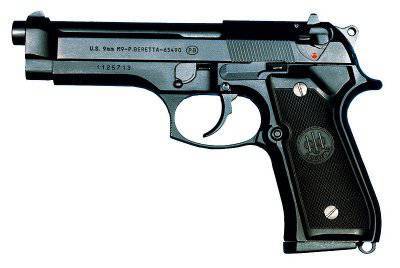 Strange as it may seem, but the Italian weapon was created initially not at all for the Italians, but for the US market, and later to participate in the competition for a new pistol for the American army, which, by the way, Beretta 92F won. But we will not go into the details of how patriotic it was, and what happened as a result, since stories There are still quite a few gaps that many fill with fiction and move on to a direct acquaintance with weapons. Externally, the Beretta M 92 pistol is a full-sized pistol, which, by its very appearance, speaks of a fairly large mass, but there is an offset balance of the weapon in the direction of the handle, which allows you to hold the pistol for an extended hand for a long time. But all this was already somewhere, namely in the 951 model, which I propose to consider as the first of the whole family of these weapons, since it was in it that the basic solutions were applied, which were realized in subsequent pistols from one model to another. It was in this gun that a modified locking system of the barrel of the weapon with a locking wedge was applied, and a long cut-out was made in the cover-casing, which also served as a window for ejection of spent cartridges and, albeit slightly, facilitated the design of the weapon, so that this model of the gun can be called a full progenitor, although there were some differences. In general, we return to the pistols of the 92 family, and leave the 951 alone.
Strange as it may seem, but the Italian weapon was created initially not at all for the Italians, but for the US market, and later to participate in the competition for a new pistol for the American army, which, by the way, Beretta 92F won. But we will not go into the details of how patriotic it was, and what happened as a result, since stories There are still quite a few gaps that many fill with fiction and move on to a direct acquaintance with weapons. Externally, the Beretta M 92 pistol is a full-sized pistol, which, by its very appearance, speaks of a fairly large mass, but there is an offset balance of the weapon in the direction of the handle, which allows you to hold the pistol for an extended hand for a long time. But all this was already somewhere, namely in the 951 model, which I propose to consider as the first of the whole family of these weapons, since it was in it that the basic solutions were applied, which were realized in subsequent pistols from one model to another. It was in this gun that a modified locking system of the barrel of the weapon with a locking wedge was applied, and a long cut-out was made in the cover-casing, which also served as a window for ejection of spent cartridges and, albeit slightly, facilitated the design of the weapon, so that this model of the gun can be called a full progenitor, although there were some differences. In general, we return to the pistols of the 92 family, and leave the 951 alone. So, as noted above, the weapon has quite serious dimensions and weight, while it remains easy to handle and daily wear, which should be noted as a unique feature of the weapon, since not all pistols of such dimensions and weight can boast the same. Such a result is not just an accident, but the vast experience gained by the Italian company, plus the talents and skills of the “fathers” of this pistol — designers Carlo Beretta, Giuseppe Mazetti and Vittorio Valle. Why there was a reservation that this gun was originally created for the United States, it is clear at first glance at the weapon, the tilt of the handle, the location of the pistol controls actually repeat those of the “American” Colt M1911 pistol, although this is indirect evidence, but we will adhere to the generally accepted version. In principle, the desire to get the maximum profit from weapons is quite understandable, and such a market as the US civilian arms market cannot bring in a small income. Actually, this is how the Beretta 92 appeared, which became the basis for a new family of pistols, and later, moreover, the basis for subsequent weapon models with various innovations and for various ammunition, including virtually the entire list more or less common in Europe and the USA. and beyond.
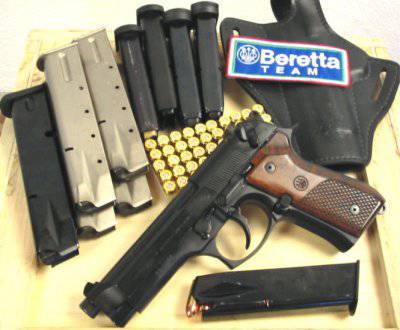 If you look at the device of a weapon, then everything in it is quite simple and understandable, although it may introduce you into some kind of stupor, if you do not know which way to look. So, the gun itself (the original model) consists of 65 parts, which is not the smallest quantity for such weapons, and, accordingly, requires serious costs in production. The recoil spring is located under the barrel of the weapon, and the barrel bore is locked using a separate part, which is commonly called the locking wedge, since the phrase “locking larva” is not entirely true, but this will be described in more detail in the description of the pistol. Weapon controls consist of a standard complete set, including a shutter lag lever, a magazine eject button, a fuse switch, a trigger and, of course, a trigger, there is also a separate switch for disassembling the weapon. It feeds a pistol from a detachable box magazine with a capacity of 15 cartridges. The trigger mechanism for different versions may be different, but for all pistols the combat spring is twisted and is placed in the handle of the weapon. Let's try to figure out now how this all works when fired.
If you look at the device of a weapon, then everything in it is quite simple and understandable, although it may introduce you into some kind of stupor, if you do not know which way to look. So, the gun itself (the original model) consists of 65 parts, which is not the smallest quantity for such weapons, and, accordingly, requires serious costs in production. The recoil spring is located under the barrel of the weapon, and the barrel bore is locked using a separate part, which is commonly called the locking wedge, since the phrase “locking larva” is not entirely true, but this will be described in more detail in the description of the pistol. Weapon controls consist of a standard complete set, including a shutter lag lever, a magazine eject button, a fuse switch, a trigger and, of course, a trigger, there is also a separate switch for disassembling the weapon. It feeds a pistol from a detachable box magazine with a capacity of 15 cartridges. The trigger mechanism for different versions may be different, but for all pistols the combat spring is twisted and is placed in the handle of the weapon. Let's try to figure out now how this all works when fired.As in all firearms, the source of energy for the work of automation in this case are powder gases, which are formed during the combustion of gunpowder and pressurize the sleeve, and then - in the barrel of the weapon. It is their expansion that leads to the fact that the bullet leaves the barrel of the gun, and its working mechanisms are set in motion. Naturally, the movement does not arise from nowhere. In order to understand why, even in the simplest design with a free gate, the shutter moves, you need to imagine how the powder gases act during a shot. If you do not think about what is happening, it seems that the powder gases simply push the bullet out of the barrel, since it is a kind of piston, during the movement of which more and more space is formed for the products of powder burning, but this is not quite so. The fact is that in this system there is another weak point besides the bullet - the sleeve. If we take as an example the automation system with a free gate, then the sleeve simply transmits that large, but short-term effort to the cover-bolt, so that it rolls back and took it out of the chamber. And this happens precisely due to the transfer of the impulse to the casing of the bolt, and not in the form of pushing it with a sleeve, therefore the extraction of the spent cartridge occurs only after the bullet left the barrel, which means the powder gases were used efficiently, and the sleeve itself remained intact. This all works so only because the bullet has a much smaller weight than the casing-shutter with a sleeve, and therefore, it will have a much higher speed. But this simple system with a free gate, the brightest and closest to our man, the representative of which is the Makarov pistol. In the case of the Beretta 92 pistol, everything is somewhat more complicated, but not by much.
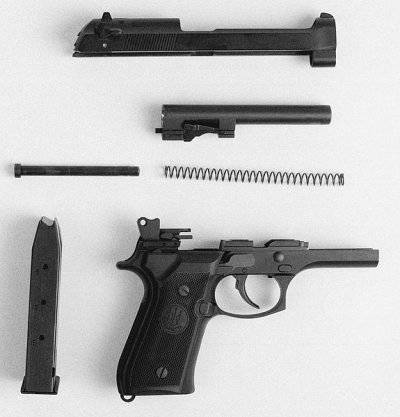 In the gun Beretta 92 applied scheme of automation with a short stroke of the barrel, and locking the barrel with a locking wedge, swinging in a vertical plane. In the normal position, this wedge is raised up, its lateral protrusions enter into vertical grooves on the inner surface of the housing and bolt, while the locking wedge itself is between the chamber and the protrusion on the outer surface of the barrel, that is, it cannot move back and forth independently. Thus, the sleeve transmits the impulse to the cover-bolt, which has to pull not only the sleeve, but also the barrel of the weapon. True, he pulls it for long. When fired, the barrel and bolt begin a joint path in the direction opposite to the gunshot, but after a while the guide spring of the return spring begins to act on the locking wedge under the barrel, causing it to fall, the side wedge projections begin to go down the notches on the inside of the housing-bolt and eventually come out of them, at the same time becoming part of the guides for the housing-bolt. The barrel of the weapon stops, and the shutter-casing continues to move backward, removing the cartridge case from the chamber, throwing it through the window to eject the cartridge case, and also cocking the trigger. In its rearmost position, the cover-shutter stops and, under the influence of the return spring, begins to move forward. At the same time, he removes the new cartridge from the magazine and inserts it into the chamber, and then, resting on the breech of the weapon, begins to push the barrel forward, which leads to the raising of the locking wedge that enters the vertical cut on the inner surface of the housing-bolt and locks securely bore to the next shot. In general, it works that way.
In the gun Beretta 92 applied scheme of automation with a short stroke of the barrel, and locking the barrel with a locking wedge, swinging in a vertical plane. In the normal position, this wedge is raised up, its lateral protrusions enter into vertical grooves on the inner surface of the housing and bolt, while the locking wedge itself is between the chamber and the protrusion on the outer surface of the barrel, that is, it cannot move back and forth independently. Thus, the sleeve transmits the impulse to the cover-bolt, which has to pull not only the sleeve, but also the barrel of the weapon. True, he pulls it for long. When fired, the barrel and bolt begin a joint path in the direction opposite to the gunshot, but after a while the guide spring of the return spring begins to act on the locking wedge under the barrel, causing it to fall, the side wedge projections begin to go down the notches on the inside of the housing-bolt and eventually come out of them, at the same time becoming part of the guides for the housing-bolt. The barrel of the weapon stops, and the shutter-casing continues to move backward, removing the cartridge case from the chamber, throwing it through the window to eject the cartridge case, and also cocking the trigger. In its rearmost position, the cover-shutter stops and, under the influence of the return spring, begins to move forward. At the same time, he removes the new cartridge from the magazine and inserts it into the chamber, and then, resting on the breech of the weapon, begins to push the barrel forward, which leads to the raising of the locking wedge that enters the vertical cut on the inner surface of the housing-bolt and locks securely bore to the next shot. In general, it works that way.Such an automation system is a direct descendant of the automation system for pistols proposed by Browning, one of the greatest gunsmiths in history, but it is still quite modernized enough to speak of complete similarity, but the principle is the same, only the elements that implement the work are different. The positive quality of such a system is that the barrel of the weapon moves without bias, which makes the operation of the weapon smoother, and firing from it is more accurate, however, it is difficult to say that this is only the reason, after all, in the beginning of the twentieth century, however, it was distinguished by a sufficiently high accuracy, at least very few people complained. Despite the fact that the gun has a sufficiently large window for ejection of spent cartridges, which makes its system virtually open, the 92 Beretta pistol turned out to be quite resistant to dirt, and this is based on the locking element that interacts with the shutter-casing through sliding. Naturally, if a weapon is completely immersed in liquid mud and allowed to penetrate into all gun nodes, it cannot fire, but dust, sand, moisture within reasonable limits, the weapon endures quite calmly, though it wears out pretty badly, but it’s hard to name another pistol that could boast a high service life under both normal and unfavorable conditions. In general, if there is a desire that the weapon lasts long enough, regular cleaning / lubrication is an integral part of owning this gun, as well as any other weapon.
From high heights in the form of a weapon design and a description of its work, we turn to a more mundane topic - a brief description of various modifications of this gun. Well, you need to start with the fact that despite the fact that the forefather of the whole family was a Beretta 92 pistol, it was released only 5000 units for the first year, after which the production of this model was curtailed. So the original 92 Beretta is a rarity in some way. Further, modifications have already gone after it, which added any possibilities to the weapon or modified already existing ones.
The first modification was the Berette 92S pistol. Its main difference lies in the location of the switch fuse arms, which was moved from the frame of the gun on the cover-bolt. This innovation was dictated by the Italian police, who first drew attention to the novelty, although the gun for them was not originally developed. It would be foolish not to take this opportunity and not to adapt weapons to the requirements, it can be said that it was from this model that the gun began to bring huge profits to its creators. In addition to transferring the fuse, the principle of its operation has changed. If in the 92 model, the fuse simply blocked the sear and the shutter-casing, both when the trigger was cocked and when it was lowered, then in the 92S model, turning on the fuse resulted in a smooth descent of the trigger, after which it blocked, just as the drummer and the trigger were blocked. An interesting point is the several possibilities of removing the weapon from the fuse. So, you can simply move the switch, and you can simultaneously pressing the trigger and pulling the trigger to bring the weapon into readiness. Separately, neither pull the trigger nor pull the trigger when the safety is off. It is also necessary to mention another feature of the 92S model, as well as the original gun, in this sample, the store eject button is located not at the base of the safety bracket, as in subsequent models, but on the left side of the handle at the bottom right corner; and not a latch at the bottom of the handle like in PM. This feature of these two models immediately gives them away, so you can call a weapon model without a shadow of a doubt just by glancing at it. At the same time, stores for later modifications, in which the eject button is located at the place already familiar to pistols, can also be used in these models.
The following modification of the pistol is especially interesting because it was from her that the introduction of these weapons into the US Army began. This model is designated as the Beretta 92SB, it was created specifically for the US Army. The main difference from the previous models is to move the store eject button to its usual place, and also added the ability to transfer the button from the left side of the weapon to the right. In addition, there were changes in the operation of the device for protection from an accidental shot. So, with the fuse turned on, the trigger retained the ability to move, but was shared with the drummer with a small liner. By the way, he closed the drummer literally until the last moment of the trigger stroke. On the basis of this pistol, a compact version of the weapon was also created, which was distinguished by a shorter barrel in an 103 millimeter and, accordingly, a shorter casing-bolt. In addition, the length of the handle of the weapon has decreased, well, and, naturally, the capacity of a regular store to 13 cartridges has decreased, although the use of stores from full-fledged samples is not excluded.
In 1983, a new army Beretta appeared. This time after the numbers was the letter F, but these are not all the changes that were in this weapon. It was this gun that became the armament of the US Army, and what would have happened required the following adjustments. Of the external innovations, the modified form of the safety guard of the weapon, which has now become more convenient when firing a pistol using two hands, immediately catches the eye. The angle of the pistol grip was changed, but this is hardly noticeable, since the angle has changed only for the front part of the grip. Also, to increase the life of the barrel, its channel began to be chrome-plated. Well, on a voluntary basis, the company has changed the protective coating of the external parts of the weapon to a more reliable and durable. Unfortunately, with this gun was not all as smooth as we would like. In the long run, he did not withstand the casing-bolt of the weapon, although on the samples presented for testing everything was in order. Apparently, the impact of mass production of weapons and not the highest quality material. Nevertheless, the weapon worked flawlessly, only less than the declared resource, because the contract for the supply of this gun to the US Army was suspended.
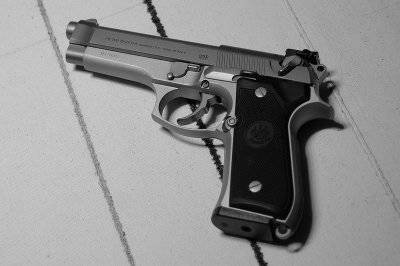 To get rid of such a disgraceful disease of his weapon and continue to supply the army of the United States of America, the Beretta company modified its pistol, now it was already called Beretta 92FS, it is he who is now in service with the US Army under the name M9. In fact, it was all the same gun, but it significantly increased the strength of the casing-bolt, which made it even more tenacious than it was stated. In addition, to save the Americans, who are very fond of ammunition more powerfully, from injuries, a kind of disc was installed on the head of the axle of the trigger, which prevents the shutter-casing from falling apart in case of its destruction and flying into the face of the arrow. Actually here is this sample gun Beretta 92 and is the most common in the world.
To get rid of such a disgraceful disease of his weapon and continue to supply the army of the United States of America, the Beretta company modified its pistol, now it was already called Beretta 92FS, it is he who is now in service with the US Army under the name M9. In fact, it was all the same gun, but it significantly increased the strength of the casing-bolt, which made it even more tenacious than it was stated. In addition, to save the Americans, who are very fond of ammunition more powerfully, from injuries, a kind of disc was installed on the head of the axle of the trigger, which prevents the shutter-casing from falling apart in case of its destruction and flying into the face of the arrow. Actually here is this sample gun Beretta 92 and is the most common in the world.But on this variety weapons does not end in 1990, another modification of the gun appeared. In fact, it was the same back as 92FS, but now it only had a double-action trigger mechanism, that is, each shot was made by self-artillery, which significantly increased the trigger pressure, and, as a result, had a negative impact on the accuracy of fire, although this habits. Also from the safety mechanism as unnecessary was removed the possibility of a safe descent of the trigger. This model is designated as the Beretta 92DS, but it has not received much popularity, such as in the previous version.
In the same year, another modification appeared, in which there is no fuse at all. This model also has a trigger mechanism, which allows firing only by self-platooning, while the manufacturer has increased the trigger pressure on the trigger even more to make the gun safer. When falling, the weapon is protected from an accidental shot by blocking the firing pin, which is removed only on the last millimeters of the trigger stroke. This model of the pistol is meant as Beretta 92D, and it is natural that it did not receive either wide distribution or fame because of its specific design.
I wanted to skip the next model of the pistol, as it is an offshoot from the main family, but, remembering how often 92 beretta empows the people in the street to shoot automatically, and the blue screen is not in a hurry to challenge it, decided to devote one paragraph to the pistol Beretta 93R. This weapon is old, despite its popularity among the masses, and it really has the ability to shoot in short bursts with a cut-off 3 cartridge, but not a long queue. Without going into details of the difference in the device of the pistol in comparison with the previous versions (who read to this place - my respect), you only need to note that the weapon has a reinforced casing-bolt, as well as a heavier barrel protruding in front of the casing-bolt. From the muzzle there are holes that play the role of a kind of a muzzle toromoza-recoil compensator to prevent the pistol from being thrown up when firing. The rate of fire is 1100 shots per minute, food is supplied from detachable magazines with a capacity of 20 cartridges, although standard stores with a capacity of 15 cartridges can also be used. A little further along the frame of the weapon from the safety guard, a handle is installed for more convenient control of the weapon during firing, and the pistol is also equipped with a removable shoulder rest. Out of production more than 20 years ago, as there is a separate class of weapons - submachine guns, in which this gun does not win. Well, it would not be superfluous to say that the resource of this pistol is not very high compared with even the most medium machine pistols.
It would be nice to stop after that, but once I started it, I’ll continue. In addition to all the above models, there is also a “Frenchman” named PAMAS G1. It appeared due to the lack of modern pistols in France at the end of the 80s of the last century, however, for some reason, there were no manufacturers who could have taken up the elimination of such a problem. She responded to the call for help and solved this problem by creating a Beretta 92G pistol model, which differed from 92FS in that the fuse switch had three positions — two “classical” and one that provided safe triggering of the trigger, instead of two positions, in one of which the safe descent function was automatic. This gun was adopted by the French gendarmerie in 1989 year, and in 1990 and 1991 year entered service with the Navy and the army.
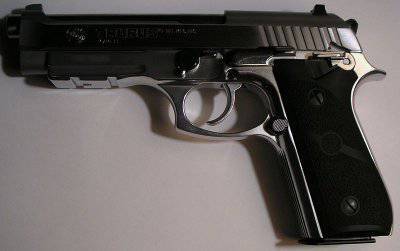 Do not forget about the versions of weapons that are manufactured under license from other manufacturers. So, the most famous are the pistols of the Brazilian company Taurus. A very successful purchase of a license to manufacture and upgrade weapons actually made the Brazilian company known in the market for short-barreled weapons in an instant. By the way, thanks to the timely modernization and a wide range of ammunition used in Brazilian pistols, the 92 Beretta variants from this company are popular now, especially in the US civilian market, and are also used by the armies of several countries, including Brazil. But I wrote about these pistols in detail earlier in the articles: Brazilian Beretta from Taurus chambered for .380АСР; Brazilian Berettas from Taurus chambered for .40S & W; Brazilian Beretts from Taurus chambered for 9х19.
Do not forget about the versions of weapons that are manufactured under license from other manufacturers. So, the most famous are the pistols of the Brazilian company Taurus. A very successful purchase of a license to manufacture and upgrade weapons actually made the Brazilian company known in the market for short-barreled weapons in an instant. By the way, thanks to the timely modernization and a wide range of ammunition used in Brazilian pistols, the 92 Beretta variants from this company are popular now, especially in the US civilian market, and are also used by the armies of several countries, including Brazil. But I wrote about these pistols in detail earlier in the articles: Brazilian Beretta from Taurus chambered for .380АСР; Brazilian Berettas from Taurus chambered for .40S & W; Brazilian Beretts from Taurus chambered for 9х19. Proceeding from all of the above, it is safe to say that the Italian Beretta 92 weapon is, if not a cult, then quite worthy to put it in one row at least with the same Colt M1911. And although the gun has flaws, without them, unfortunately, nowhere, but its positive qualities completely overlap all the negative ones. So the weapon has a fairly high accuracy, the norm is considered when at a distance of 50 meters all the bullets fall into a circle with a diameter of 70 millimeters, naturally under ideal conditions. In addition, it is quite comfortable when holding, despite its impressive weight. The simplicity of the design made the gun resistant to reasonable pollution, without fanaticism. Well, the fact that the weapon does not shoot out is accidentally guaranteed by a safety device that literally blocks everything that can move (depending on the modification). Well, for the sake of justice flaws. Big weight and dimensions for hidden and daily carrying, which in my opinion is a matter of habit. Thick grip arms that are uncomfortable for a person with short fingers, and, perhaps, that's all. Here she is such a Beretta 92.
Information